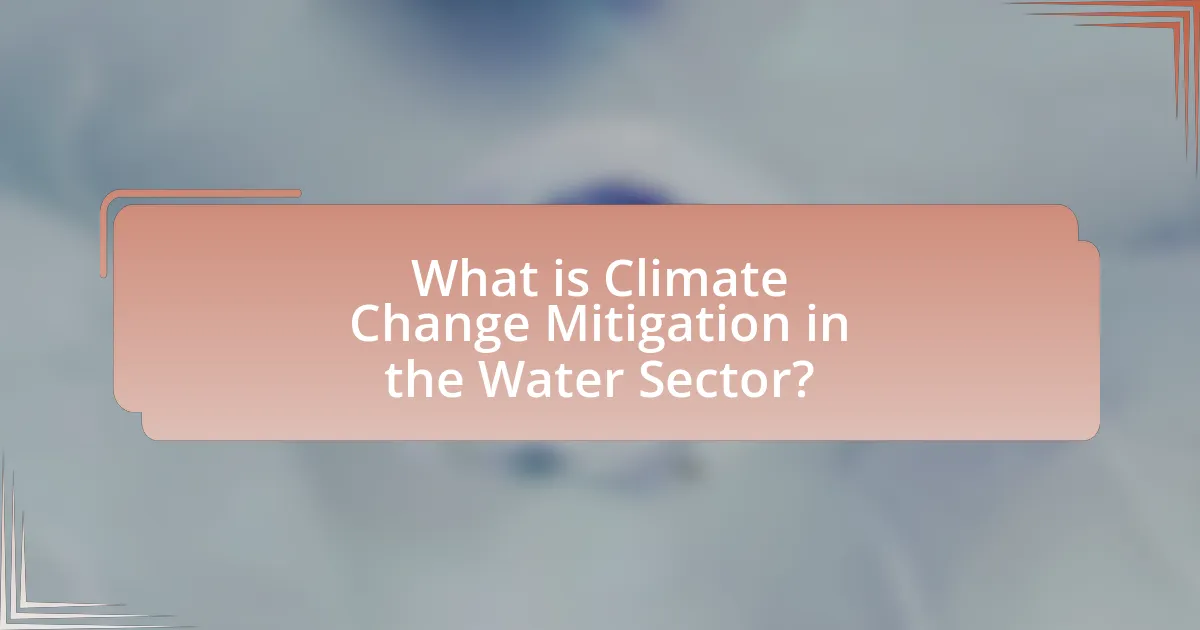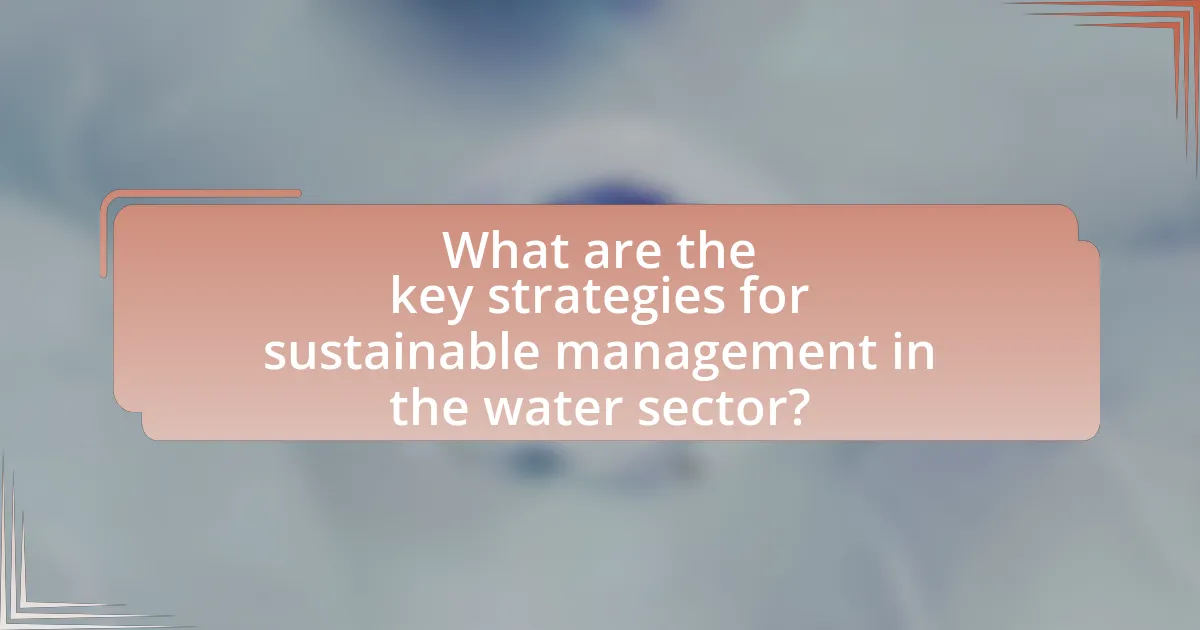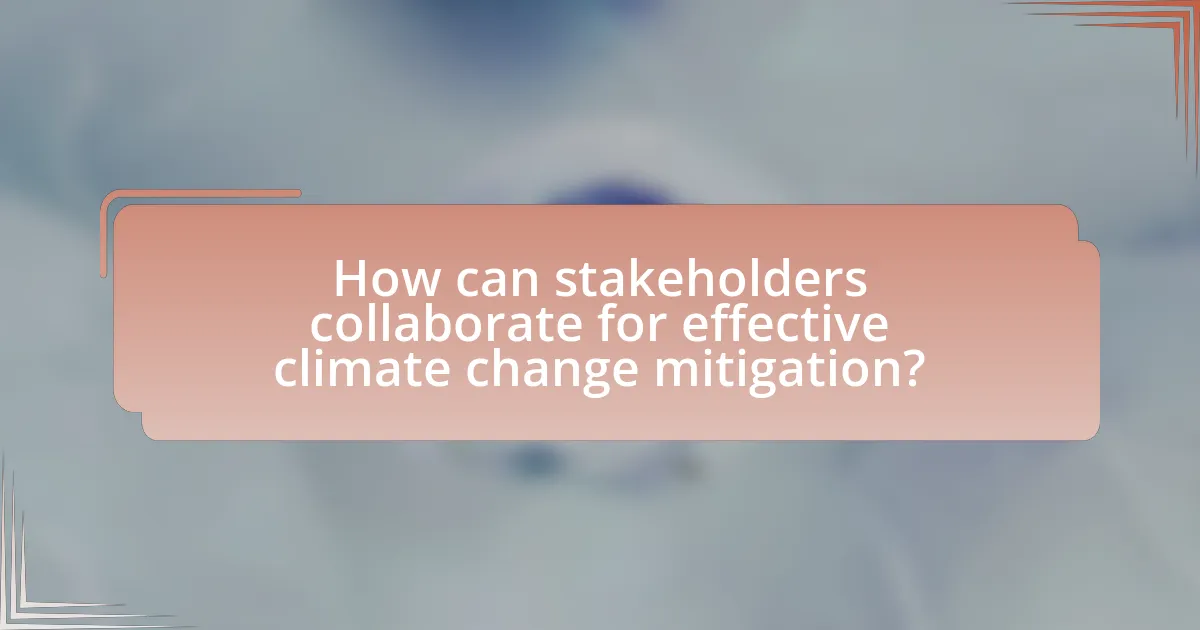Climate change mitigation in the water sector encompasses strategies aimed at reducing greenhouse gas emissions and enhancing resilience to climate impacts through effective water management practices. The article explores the significant effects of climate change on water resources, including altered precipitation patterns, increased evaporation, and deteriorating water quality, which lead to water scarcity and ecosystem degradation. It emphasizes the importance of implementing sustainable practices, such as integrated water resource management, water conservation technologies, and resilient infrastructure, to ensure water security and support climate adaptation efforts. Additionally, the article highlights the role of stakeholder collaboration and community engagement in promoting effective water management strategies to address the challenges posed by climate change.

What is Climate Change Mitigation in the Water Sector?
Climate change mitigation in the water sector refers to strategies and actions aimed at reducing greenhouse gas emissions and enhancing resilience to climate impacts within water management practices. This includes implementing efficient water use, promoting sustainable water infrastructure, and adopting practices that minimize the carbon footprint of water supply and treatment processes. For instance, transitioning to renewable energy sources for water treatment facilities can significantly lower emissions, as evidenced by studies showing that energy consumption in water treatment accounts for a substantial portion of operational costs and emissions.
How does climate change impact water resources?
Climate change significantly impacts water resources by altering precipitation patterns, increasing evaporation rates, and affecting water quality. These changes lead to more frequent and severe droughts in some regions, while others may experience increased flooding. According to the Intergovernmental Panel on Climate Change (IPCC), global warming is expected to intensify the hydrological cycle, resulting in altered river flows and reduced snowpack, which are critical for water supply in many areas. Additionally, rising temperatures can lead to the degradation of water quality due to increased runoff and higher concentrations of pollutants.
What are the primary effects of climate change on water availability?
Climate change primarily affects water availability by altering precipitation patterns, increasing evaporation rates, and causing more frequent and severe droughts and floods. These changes lead to reduced freshwater supplies in many regions, as evidenced by studies indicating that global warming has already contributed to a decline in snowpack and altered river flow patterns, impacting water resources for agriculture, drinking, and ecosystems. For instance, the Intergovernmental Panel on Climate Change (IPCC) reports that many areas are experiencing shifts in seasonal water availability, which can exacerbate water scarcity and affect food security.
How does climate change influence water quality?
Climate change significantly influences water quality by altering temperature, precipitation patterns, and the frequency of extreme weather events. Increased temperatures can lead to higher rates of evaporation and reduced water levels, concentrating pollutants in water bodies. Changes in precipitation can result in more intense storms, leading to increased runoff that carries sediments, nutrients, and contaminants into water sources. For instance, a study published in the journal “Environmental Science & Technology” found that heavy rainfall events can elevate levels of pathogens and nutrients in surface waters, negatively impacting aquatic ecosystems and human health. Additionally, climate change can exacerbate algal blooms, which further degrade water quality by producing toxins and depleting oxygen levels.
Why is mitigation important in the water sector?
Mitigation is important in the water sector because it helps reduce the impacts of climate change on water resources and ensures sustainable management. Effective mitigation strategies, such as improving water efficiency and enhancing watershed management, can decrease the frequency and severity of water scarcity and flooding events. According to the Intergovernmental Panel on Climate Change (IPCC), climate change is projected to exacerbate water stress in many regions, making mitigation essential for maintaining water quality and availability. By implementing mitigation measures, the water sector can protect ecosystems, support agricultural productivity, and safeguard human health, thereby contributing to overall resilience against climate change.
What are the potential consequences of inaction on water resources?
Inaction on water resources can lead to severe consequences, including water scarcity, ecosystem degradation, and increased conflict over water access. Water scarcity affects approximately 2 billion people globally, leading to health issues, reduced agricultural productivity, and economic instability. Ecosystem degradation occurs as rivers and wetlands dry up, resulting in loss of biodiversity; for instance, the World Wildlife Fund reports that freshwater species populations have declined by 83% since 1970. Additionally, competition for limited water resources can escalate tensions between communities and nations, as seen in regions like the Middle East, where water disputes have historically contributed to conflict.
How can effective mitigation strategies enhance water security?
Effective mitigation strategies enhance water security by reducing the impacts of climate change on water resources. These strategies, such as implementing sustainable water management practices, improving infrastructure, and promoting conservation, help to maintain the availability and quality of water. For instance, the United Nations reports that integrated water resource management can lead to a 30% increase in water efficiency, thereby securing water supplies even in times of drought. Additionally, adopting green infrastructure, like rain gardens and permeable pavements, can improve groundwater recharge and reduce runoff, further enhancing water security.

What are the key strategies for sustainable management in the water sector?
Key strategies for sustainable management in the water sector include integrated water resource management (IWRM), promoting water conservation, enhancing water-use efficiency, and investing in infrastructure for sustainable water supply. IWRM facilitates the coordinated development and management of water, land, and related resources, ensuring sustainability and equitable access. Water conservation practices, such as rainwater harvesting and wastewater recycling, significantly reduce demand on freshwater sources. Enhancing water-use efficiency through technologies like drip irrigation can increase agricultural productivity while minimizing water waste. Additionally, investing in resilient infrastructure, such as green infrastructure and smart water systems, supports long-term sustainability and climate resilience in the water sector. These strategies are essential for addressing the challenges posed by climate change and ensuring the availability of clean water for future generations.
How can water conservation practices contribute to climate change mitigation?
Water conservation practices contribute to climate change mitigation by reducing the energy required for water treatment and distribution, thereby lowering greenhouse gas emissions. Efficient water use decreases the demand on water supply systems, which often rely on energy-intensive processes such as pumping and treatment. For instance, the U.S. Environmental Protection Agency estimates that reducing water use by 20% can save approximately 1.5 trillion gallons of water annually, leading to significant energy savings and a reduction in carbon emissions associated with water management. Additionally, practices like rainwater harvesting and xeriscaping can enhance local water resilience, further supporting climate adaptation efforts.
What are the most effective water-saving technologies?
The most effective water-saving technologies include drip irrigation, rainwater harvesting, and smart water management systems. Drip irrigation delivers water directly to the plant roots, reducing evaporation and runoff, and can save up to 50% more water compared to traditional irrigation methods. Rainwater harvesting systems capture and store rainwater for later use, which can significantly reduce reliance on municipal water supplies. Smart water management systems utilize sensors and data analytics to optimize water usage in real-time, leading to reductions in water waste. These technologies collectively contribute to sustainable water management practices essential for climate change mitigation.
How can community engagement enhance water conservation efforts?
Community engagement enhances water conservation efforts by fostering collective responsibility and awareness among individuals. When communities actively participate in water conservation initiatives, they are more likely to adopt sustainable practices, such as reducing water waste and implementing efficient irrigation techniques. Research indicates that community-led programs can lead to a 20-30% reduction in water usage, as seen in various case studies where local involvement was prioritized. Engaging community members also facilitates knowledge sharing, enabling them to learn from each other’s experiences and successes in conservation efforts. This collaborative approach not only strengthens community ties but also amplifies the impact of water conservation strategies, making them more effective and sustainable over time.
What role does infrastructure play in sustainable water management?
Infrastructure is essential for sustainable water management as it facilitates the efficient distribution, treatment, and conservation of water resources. Effective infrastructure, such as reservoirs, pipelines, and treatment plants, enables the collection and storage of rainwater, reduces water loss through leaks, and ensures access to clean water for communities. For instance, according to the United Nations, investing in water infrastructure can yield a return of up to $4 for every $1 spent, highlighting its economic and environmental benefits. Additionally, well-designed infrastructure can enhance resilience to climate change impacts, such as droughts and floods, by improving water storage and management capabilities.
How can green infrastructure reduce the impacts of climate change?
Green infrastructure can reduce the impacts of climate change by enhancing natural processes that manage stormwater, improve air quality, and increase biodiversity. For instance, green roofs and permeable pavements absorb rainwater, reducing runoff and mitigating flooding, which is increasingly important as climate change leads to more intense storms. Additionally, urban trees and vegetation can lower temperatures through shade and evapotranspiration, thereby combating the urban heat island effect. Research indicates that cities implementing green infrastructure can see a reduction in surface temperatures by up to 5 degrees Fahrenheit, which contributes to overall climate resilience. Furthermore, green spaces promote carbon sequestration, helping to offset greenhouse gas emissions.
What are the benefits of investing in resilient water systems?
Investing in resilient water systems enhances water security, reduces vulnerability to climate change, and promotes sustainable resource management. Resilient water systems can withstand extreme weather events, ensuring a reliable supply of clean water even during droughts or floods. For instance, the World Bank reports that investing in resilient infrastructure can yield economic returns of up to four times the initial investment by minimizing damage costs and improving service delivery. Additionally, these systems support ecosystem health, which is crucial for maintaining biodiversity and mitigating climate impacts.

How can stakeholders collaborate for effective climate change mitigation?
Stakeholders can collaborate for effective climate change mitigation by establishing partnerships that integrate diverse expertise and resources. Collaborative efforts can include joint research initiatives, shared funding for sustainable projects, and the development of comprehensive policies that address climate impacts on water resources. For instance, the United Nations Framework Convention on Climate Change emphasizes the importance of multi-stakeholder engagement, highlighting that coordinated actions among governments, businesses, and communities can lead to more effective climate strategies. Additionally, the Global Water Partnership reports that stakeholder collaboration in water management can enhance resilience to climate change, demonstrating that collective action is essential for achieving sustainable outcomes in the water sector.
What partnerships are essential for successful water management strategies?
Successful water management strategies require partnerships between government agencies, local communities, non-governmental organizations (NGOs), and private sector stakeholders. These collaborations facilitate resource sharing, knowledge exchange, and coordinated efforts to address water scarcity and quality issues. For instance, the United Nations emphasizes the importance of multi-stakeholder partnerships in achieving Sustainable Development Goal 6, which focuses on clean water and sanitation. Such partnerships enable the implementation of integrated water resource management practices, ensuring that diverse perspectives and expertise contribute to sustainable solutions.
How can government policies support collaborative efforts in the water sector?
Government policies can support collaborative efforts in the water sector by establishing regulatory frameworks that incentivize partnerships among stakeholders. For instance, policies that promote integrated water resource management (IWRM) encourage collaboration between government agencies, local communities, and private sectors, facilitating shared responsibilities and resources. Evidence from the United Nations suggests that countries implementing IWRM have seen improved water quality and availability, demonstrating the effectiveness of collaborative governance in addressing water-related challenges.
What role do NGOs play in promoting sustainable water practices?
NGOs play a crucial role in promoting sustainable water practices by advocating for policy changes, implementing community-based projects, and raising public awareness about water conservation. These organizations often collaborate with local communities to develop and promote sustainable water management techniques, such as rainwater harvesting and efficient irrigation systems. For instance, the World Wildlife Fund (WWF) has initiated projects that focus on restoring watersheds and improving water quality, demonstrating the effectiveness of NGO-led initiatives in enhancing water sustainability. Additionally, NGOs often provide training and resources to empower communities, ensuring that sustainable practices are adopted and maintained over time.
What best practices can be adopted for effective climate change mitigation in the water sector?
Effective climate change mitigation in the water sector can be achieved through practices such as implementing integrated water resource management (IWRM), enhancing water-use efficiency, and promoting sustainable agricultural practices. IWRM facilitates coordinated development and management of water, land, and related resources, ensuring sustainability and resilience against climate impacts. Enhancing water-use efficiency can reduce waste and improve supply reliability; for instance, adopting drip irrigation in agriculture can save up to 50% more water compared to traditional methods. Sustainable agricultural practices, including crop rotation and agroforestry, can improve soil health and reduce water runoff, contributing to better water quality and availability. These practices are supported by evidence from the United Nations Framework Convention on Climate Change, which emphasizes the importance of sustainable water management in climate adaptation and mitigation strategies.
How can organizations measure the success of their mitigation strategies?
Organizations can measure the success of their mitigation strategies by evaluating specific performance indicators such as reductions in greenhouse gas emissions, improvements in water quality, and enhanced resilience to climate impacts. For instance, tracking metrics like the percentage decrease in carbon emissions or the increase in water conservation rates provides quantifiable evidence of effectiveness. Additionally, organizations can conduct regular assessments and audits to compare pre- and post-implementation data, ensuring that the strategies align with established climate goals. Research indicates that organizations employing these metrics can achieve a clearer understanding of their impact, as demonstrated by case studies where water management practices led to a 30% reduction in water usage and a significant improvement in local ecosystems.
What are the common challenges faced in implementing these strategies?
Common challenges faced in implementing climate change mitigation strategies in the water sector include funding limitations, regulatory hurdles, and technological constraints. Funding limitations often hinder the development and deployment of innovative water management solutions, as many projects require significant upfront investment. Regulatory hurdles can complicate the implementation process, as existing laws may not accommodate new strategies or technologies. Additionally, technological constraints arise from the need for advanced infrastructure and systems that may not be readily available or affordable, making it difficult to adopt sustainable practices effectively. These challenges are documented in various studies, including the United Nations Environment Programme’s report on water and climate change, which highlights the financial and institutional barriers faced by water management initiatives.


